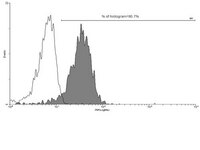Protein secondary structure from Fourier transform infrared spectroscopy: a data base analysis.
R W Sarver,W C Krueger
Analytical biochemistry
194
1991
Afficher le résumé
An infrared (ir) method to determine the secondary structure of proteins in solution using the amide I region of the spectrum has been devised. The method is based on the circular dichroism (CD) matrix method for secondary structure analysis given by Compton and Johnson (L. A. Compton and W. C. Johnson, 1986, Anal. Biochem. 155, 155-167). The infrared data matrix was constructed from the normalized Fourier transform infrared spectra from 1700 to 1600 cm-1 of 17 commercially available proteins. The secondary structure matrix was constructed from the X-ray data of the seventeen proteins with secondary structure elements of helix, beta-sheet, beta-turn, and other (random). The CD and ir methods were compared by analyzing the proteins of the CD and ir databases as unknowns. Both methods produce similar results compared to structures obtained by X-ray crystallographic means with the CD slightly better for helix conformation, and the ir slightly better for beta-sheet. The relatively good ir analysis for concanavalin A and alpha-chymotrypsin indicate that the ir method is less affected by the presence of aromatic groups. The concentration of the protein and the cell path length need not be known for the ir analysis since the spectra can be normalized to the total ir intensity in the amide I region. The ir spectra for helix, beta-sheet, beta-turn, and other, as extracted from the data-base, agree with the literature band assignments. The ir data matrix and the inverse matrix necessary to analyze unknown proteins are presented. | 1867384
 |




















